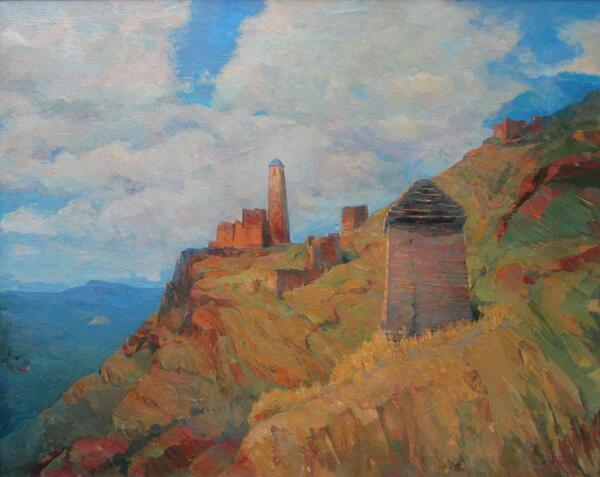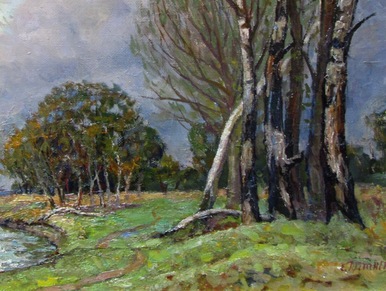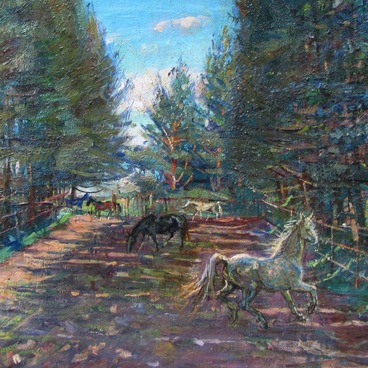The painting “Melkhista” was created by artist Vakhit Umarsultanov in 2001 in Grozny, the capital of the Chechen Republic. He painted a view of one of the settlements of Melkhista, a high-altitude historical region in the central part of the North Caucasus.
The left side of the landscape shows a small stone building with a stepped pyramidal roof on a steep mountain slope. A complex of towers is depicted behind it against a blue sky, densely covered with clouds. The bluish mountains of the Greater Caucasus are visible in the background.
The Melkhista Gorge is located in the upper reaches of Chanty-Argun River. It stretches from west to east for about 20 kilometers. It was a densely populated area in the Middle Ages, with 14 auls — tower settlements. Those were complexes of residential and military towers with peculiar architecture.
The towers usually had a square base. The height of these buildings with two or four stories varied from 10 up to 25 meters. The walls of the towers became narrower and thinner with each upper floor.
The towers were built on rocky ground without a foundation. Monoliths were laid in the bottom layer, sometimes up to two meters in height. The towers had a load-bearing pillar in the center, on which the floor beams rested. The longitudinal beams rested on cornerstones.
The ground floor of the residential tower was used for cattle and grain storage. Horses had a separate enclosure. Goats and sheep lived on the first floor of the tower, they could get there by walking on a log pathway. The family lived on the second floor, with a hearth and sleeping quarters. Food and tools were stored under the roof. The uppermost floor was used as a “battle floor”: a cauldron with pitch was placed on the roof, whereas small windows served as embrasures.
In addition to residential towers, combat towers were built in the settlements: they were used as watch posts and were not designed for a long siege. Such towers were higher and narrower.
Artist Vakhit Umarsultanov belonged to the Tsontaroy teip (teips are Chechen and Ingush tribal organizations or clans). He was born on August 20, 1950, in Kazakhstan, where his family stayed during the deportation years (the forced transfer of the Chechen and Ingush populations of the North Caucasus to Central Asia in the 1940s). After the restoration of the Checheno-Ingush Autonomous Soviet Socialist Republic in the late 1950s, the family returned to their native land.
In 1970, Umarsultanov graduated from the Penza Art College named after Konstantin Savitsky, then worked as a teacher of drawing at a boarding school. Later, he participated in republican and zonal exhibitions of the North Caucasus. He became a member of the Artists’ Union of the USSR in 1982, and the Chairman of the Union of Artists of the Chechen Republic in the early 1990s.
In December 2000–January 2001, thanks to Umarsultanov, artists from the Chechen Republic took part in the All-Russian art exhibition “To Your Name”. In May 2002, Umarsultanov organized an exhibition in the halls of the Russian Academy of Arts in Moscow, for which he collected numerous paintings by Chechen artists from all throughout Russia. In 2012, Vakhit Umarsultanov was awarded the State Prize of the Russian Federation for his contributions to culture.
The left side of the landscape shows a small stone building with a stepped pyramidal roof on a steep mountain slope. A complex of towers is depicted behind it against a blue sky, densely covered with clouds. The bluish mountains of the Greater Caucasus are visible in the background.
The Melkhista Gorge is located in the upper reaches of Chanty-Argun River. It stretches from west to east for about 20 kilometers. It was a densely populated area in the Middle Ages, with 14 auls — tower settlements. Those were complexes of residential and military towers with peculiar architecture.
The towers usually had a square base. The height of these buildings with two or four stories varied from 10 up to 25 meters. The walls of the towers became narrower and thinner with each upper floor.
The towers were built on rocky ground without a foundation. Monoliths were laid in the bottom layer, sometimes up to two meters in height. The towers had a load-bearing pillar in the center, on which the floor beams rested. The longitudinal beams rested on cornerstones.
The ground floor of the residential tower was used for cattle and grain storage. Horses had a separate enclosure. Goats and sheep lived on the first floor of the tower, they could get there by walking on a log pathway. The family lived on the second floor, with a hearth and sleeping quarters. Food and tools were stored under the roof. The uppermost floor was used as a “battle floor”: a cauldron with pitch was placed on the roof, whereas small windows served as embrasures.
In addition to residential towers, combat towers were built in the settlements: they were used as watch posts and were not designed for a long siege. Such towers were higher and narrower.
Artist Vakhit Umarsultanov belonged to the Tsontaroy teip (teips are Chechen and Ingush tribal organizations or clans). He was born on August 20, 1950, in Kazakhstan, where his family stayed during the deportation years (the forced transfer of the Chechen and Ingush populations of the North Caucasus to Central Asia in the 1940s). After the restoration of the Checheno-Ingush Autonomous Soviet Socialist Republic in the late 1950s, the family returned to their native land.
In 1970, Umarsultanov graduated from the Penza Art College named after Konstantin Savitsky, then worked as a teacher of drawing at a boarding school. Later, he participated in republican and zonal exhibitions of the North Caucasus. He became a member of the Artists’ Union of the USSR in 1982, and the Chairman of the Union of Artists of the Chechen Republic in the early 1990s.
In December 2000–January 2001, thanks to Umarsultanov, artists from the Chechen Republic took part in the All-Russian art exhibition “To Your Name”. In May 2002, Umarsultanov organized an exhibition in the halls of the Russian Academy of Arts in Moscow, for which he collected numerous paintings by Chechen artists from all throughout Russia. In 2012, Vakhit Umarsultanov was awarded the State Prize of the Russian Federation for his contributions to culture.



